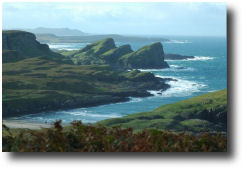Iasgair of Mottistone wins Bull Championship at Oban
A great triumph for our Highland cattle! Never having shown before, we sent our three year old bull Iasgair up to the Highland Cattle Society’s 115th Spring Show and Sale at Oban. For only the second time in its history was the male championship won by a bull from south of the Border. He was a worthy winner. The Craig Seller Cup is an historic trophy won by the most eminent names in Highland cattle, including the Queen who gained the award three times.
Iasgair was accompanied by our two-year old Cabhlaiche 2nd of Mottistone. He was third in his class.
Although technically bred by us, Iasgair was bought in embryo in February 2003 at Oban when we purchased the Champion Female, Lucy of Balure.
ConservationOn February 1st, on the close of the shooting season, Barry King started his annual works at Idlecombe. In order not to disrupt the Shoot, we avoid the area during the shooting season. This year we are concentrating on the gorse management in the northern sector. When well managed, gorse is a wonderful habitat for wildlife. Being younger and more compact, it was a good habitat for the rare Dartford Warbler when we acquired the property in 1996. Since then it has grown leggy and has lost much of its habitat value. Consequently the Dartford Warbler has disappeared.
At the newly purchased Rew Farm, we are improving the habitat for birdlife. There are many bushy hedges on the farm which need to be brought back into management. As a start, we are fencing them to protect them from the cattle and where they join up with Rew Copse, they are being belled out to act as a wildlife funnel between the Copse and them. Rew Copse will be assessed and a management plan prepared. Daphne and Mike Watson carried out their first survey during the month. It was a cold winter’s day and naturally they did not see so much as they would have done had the sun been out. They identified 20 species of which one was on the Red List and three on the Amber, and a total 261 birds. Disappointingly, however, in the northern third of Rew Copse they saw only five birds, all of different species and none in the middle third. The southern sector was not counted. Their initial survey will act as a benchmark against which our future efforts can be judged. The coppicing carried out by Philip Butchers in both Rowlands Wood and Chillingwood four years ago is coming on well. Much of the hazel is covered in catkins which bode well for their future nut fruit – benefiting the Red Squirrel and the Dormouse. Graham Sparshott has started his bird survey there. He wrote: “I started the survey in February with one eight hour visit. This enabled me to get a feel for the area on a fairly mild day when there was some early song/display activity from the resident breeding species. A typical range of woodland species were recorded including drumming Great Spotted Woodpecker and several singing Song Thrush. With regard to non-breeding species, the most interesting observation involved a flock of 180 Redwing. Unfortunately no Marsh Tits were recorded, reflecting the current decline on the Island.” Wayne Isaacson has completed his thinning in North Rowlands and carried out some further ride widening in South Rowlands and Chillingwood. The flora and fauna will both benefit. At Coombe Plantation he has widened two rides, letting more light enter the forest floor. In Rowborough, a number of veteran trees have been sky-lighted, freeing them from other trees competing with their canopies. The chlorotic conifers in Rowborough Bottom have been felled. Some enthusiasts on the Island believe adders are declining. People very seldom see an adder and for most it is only one or two in a lifetime. Adders have been seen when working in Coombe Plantation and on Mottistone Common and there is no reason to believe they should no longer be there. Likewise on Brighstone Down where they enjoy sunning themselves on the south facing slopes. Barry King regularly sees adders on Idlecombe Down. From our own anecdotal evidence, there is therefore no need for concern. The ancient burial mounds on Mottistone Down have been badly damaged by 4x4’s and trials motorcycles driving on them and children skateboarding down them. Having withstood two World Wars, French, Viking and Roman invasions over their 4,500 year history, it is sad that in the space of only 10 years in modern Britain that they should have become so endangered. English Heritage has agreed to fence them off and repair the damage. Our Ecological Consultant, Dr Jemma Batten, is preparing our application for Entry and Higher Level Schemes for the whole of our estate. We have been frustratingly delayed by the consistent inability of DEFRA to produce the required maps. The latest effort omits 80% of our farm! We are not alone in this experience. Ours is a complex estate, however, and due to the many different types of habitats, species and features, our application will be a complicated process. The Forestry Commission has transferred to us the agreement they made with Rew Farm’s previous owner for the planting of one hectare of woodland in a grass field adjoining Rew Copse. It is part of the Forestry Commission’s IOW Jigsaw Project. It is designed to encourage woodland owners to plant new woodlands to connect with existing. It will improve the habitat for the red squirrel and dormouse. Old maps show that Rew Copse and the nearby Appledurcombe Wood were once one. The scheme is effectively rejoining them and involves our neighbours the Ventnor Golf Club and Robert Corrie of Span Farm. Jigsaw planting has been widely supported on the Island.
Rew FarmIn the first month after completion of our purchase, Barry Isaacson has worked small miracles. All the farm buildings have been cleared and tidied up – a massive task. The sheds have been emptied of their contents. All metal work in the farmyard has been removed. The tin cattle sheds have been knocked down and an old entrance to the property reinstated, opening up a wonderful view of the farmland and Rew Copse from the road. The old electric fencing posts and wire have been taken down and removed. Most of the boundary fence has been replaced. The ditch in Longmead has been dug out.
A major problem was found in Longmead, the field opposite the farmhouse. There is a public surface water drain which stretches right back up to Upper Ventnor. In wet weather it is in full flow and to our horror, we soon discovered it was carrying raw sewage onto our fields. In order to protect ourselves against future prosecution, we immediately alerted the authorities. It was difficult to find anybody to accept responsibility because the Council, Southern Water and the Environment Agency all initially disowned responsibility. Nobody would promise a remedy, but the Environment Agency dropped leaflets to a number of houses up the pipe warning them that they could face heavy fines if they continued to allow their cesspits to overflow into the drain.
Highland CattleIt was an active month for our cattle. By its end 10 calves had been born, compared to none last year. They included seven by three separate Champion bulls. Two were out of Champion heifers by Champion bulls. All very exciting. Our experience last year proved that the early calves gained a great advantage by the time they were weaned. The grass is in a dire straight. Due to the dry spell the ground became very firm and when the rain arrived, instead of a gently down pour which could seep through the ground, it came in torrents. The soil could not absorb the water and so it just poured off the surfaces. Its top 2.5” became a damp sponge and soon a quagmire of mud, caused by cattle grazing or us transporting feed. It is going to take a lot of extra work later in the spring to restore it.
Taking advantage of the new extra grazing, we have transferred all our yearlings, two year old heifers and maiden three year old heifers to Rew, a total of seventy head. Our WebsiteDuring the month we welcomed our 5,000th visitor. This has been a long, slow and often disappointing haul. Since we revamped the site, however, its popularity has escalated. In February, as well as visitors from the UK, we were particularly pleased to welcome others from the United States, the Czech Republic, Canada, Sweden, Germany, Republic of Korea, Denmark, France, India, Latvia and Fiji. Surprisingly despite our Highland bull’s success, we received only two visits from Scotland! The purpose of this website is to inform you of our conservation work, share our experiences and occasionally comment on matters of interest. It is not a sales site and we receive no funding for it. We aim to provide quality and we hope that you agree that our photographs in particular demonstrate the beauty and attractions of our farm and conservation works, our cattle and the Isle of Wight in general. Thank you for supporting us. It is much appreciated. Please recommend us to your friends. Previous Months: September October November December January | ||||||||||||||||||||||||||||||||||||||
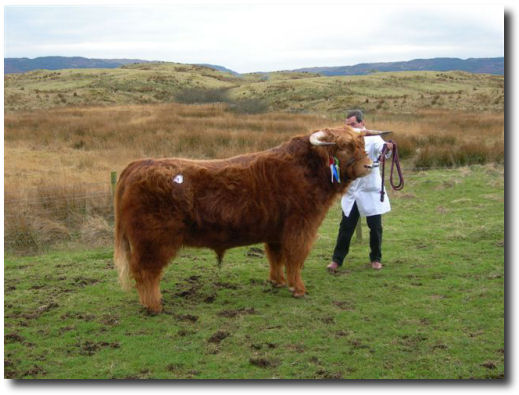
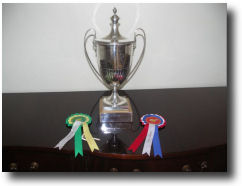
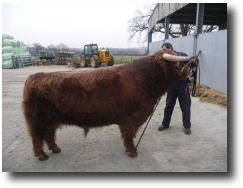
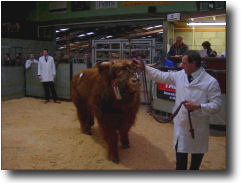
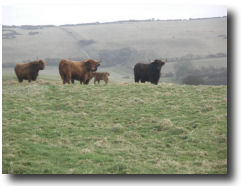
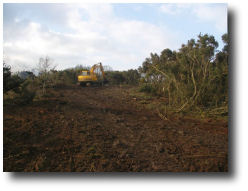 Over the last year, we have broken up the gorse into separate manageable compartments. In future it will be coppiced on a 10-year rotation basis. Its
value for wildlife will be much improved and hopefully
Over the last year, we have broken up the gorse into separate manageable compartments. In future it will be coppiced on a 10-year rotation basis. Its
value for wildlife will be much improved and hopefully


